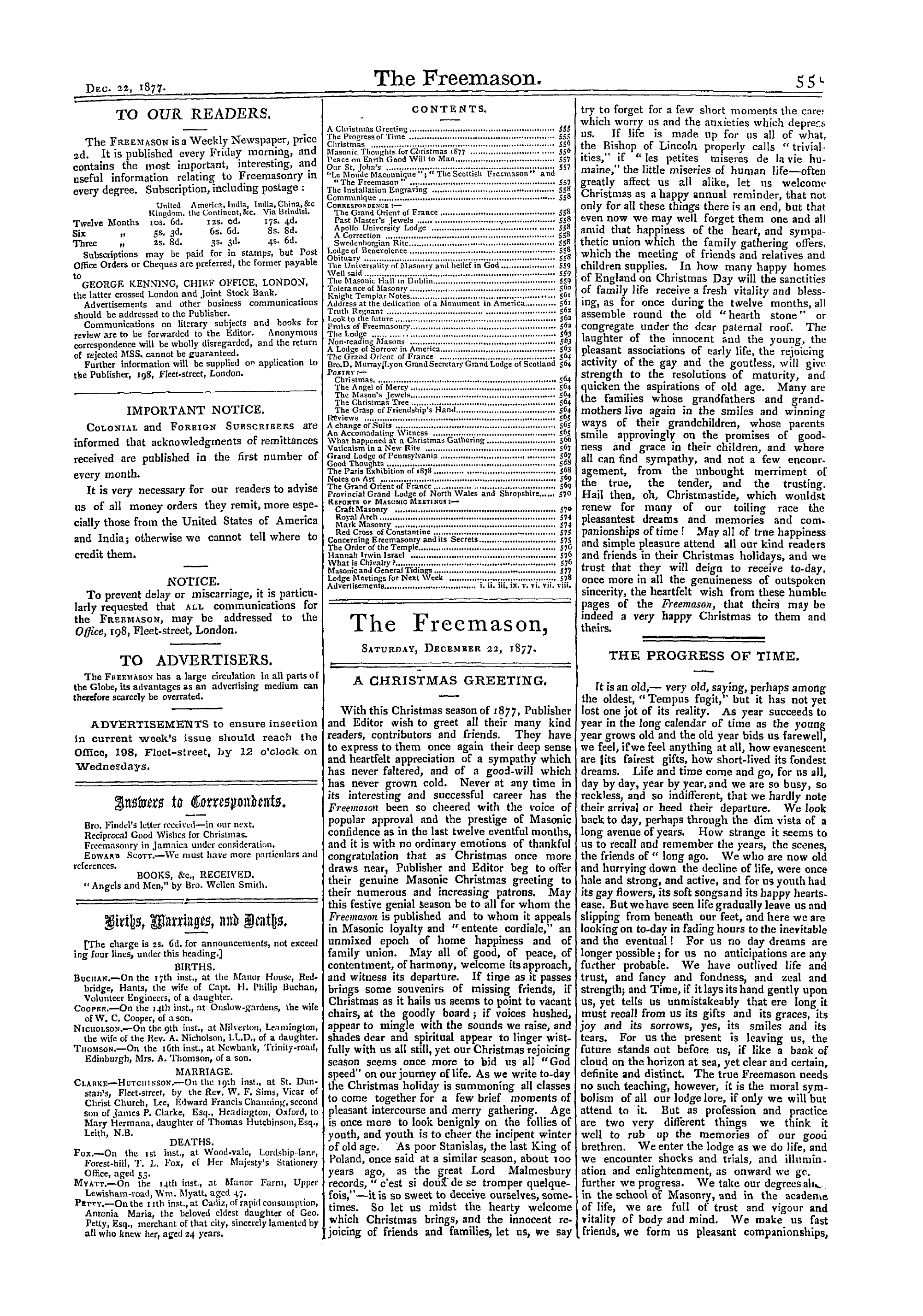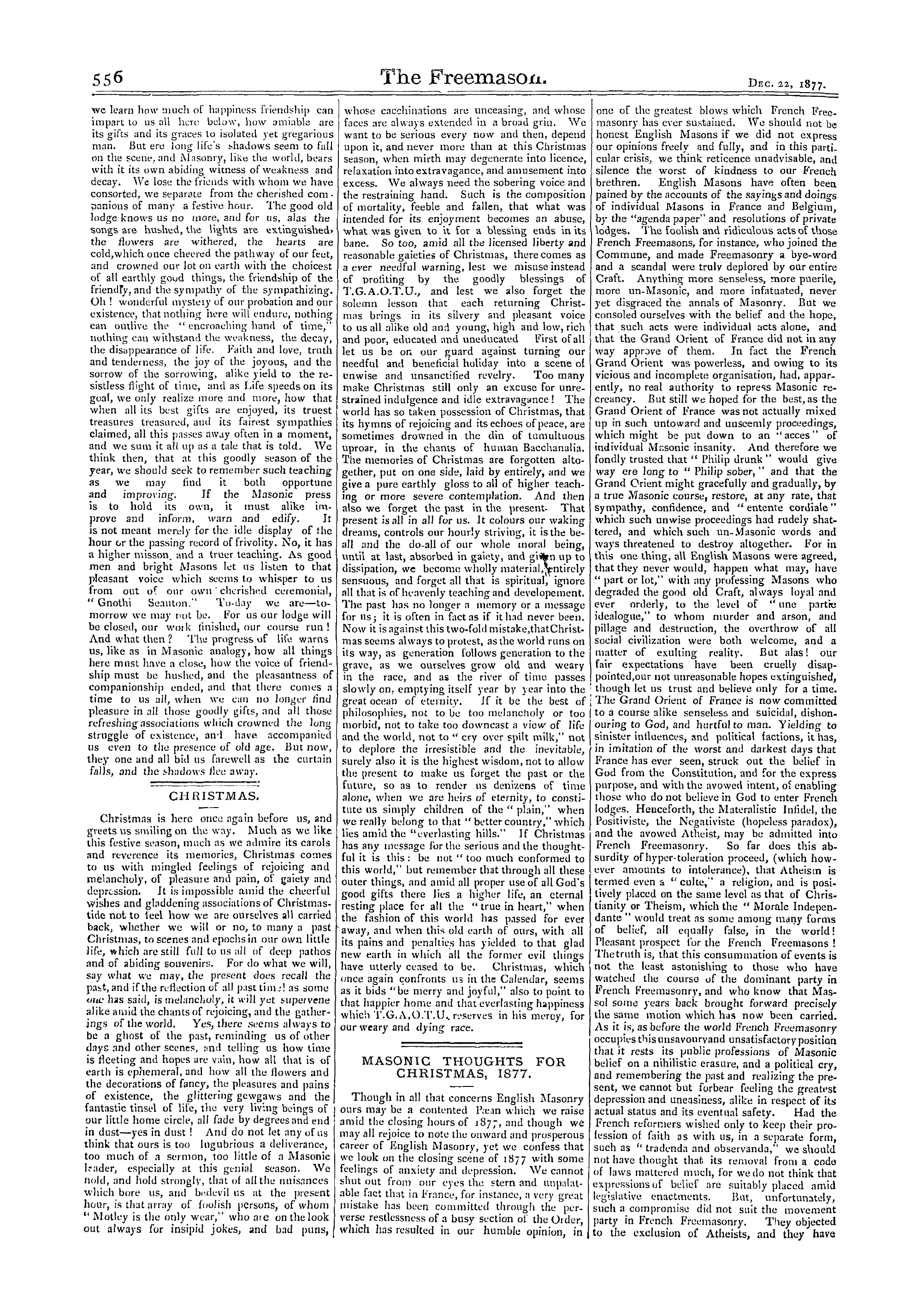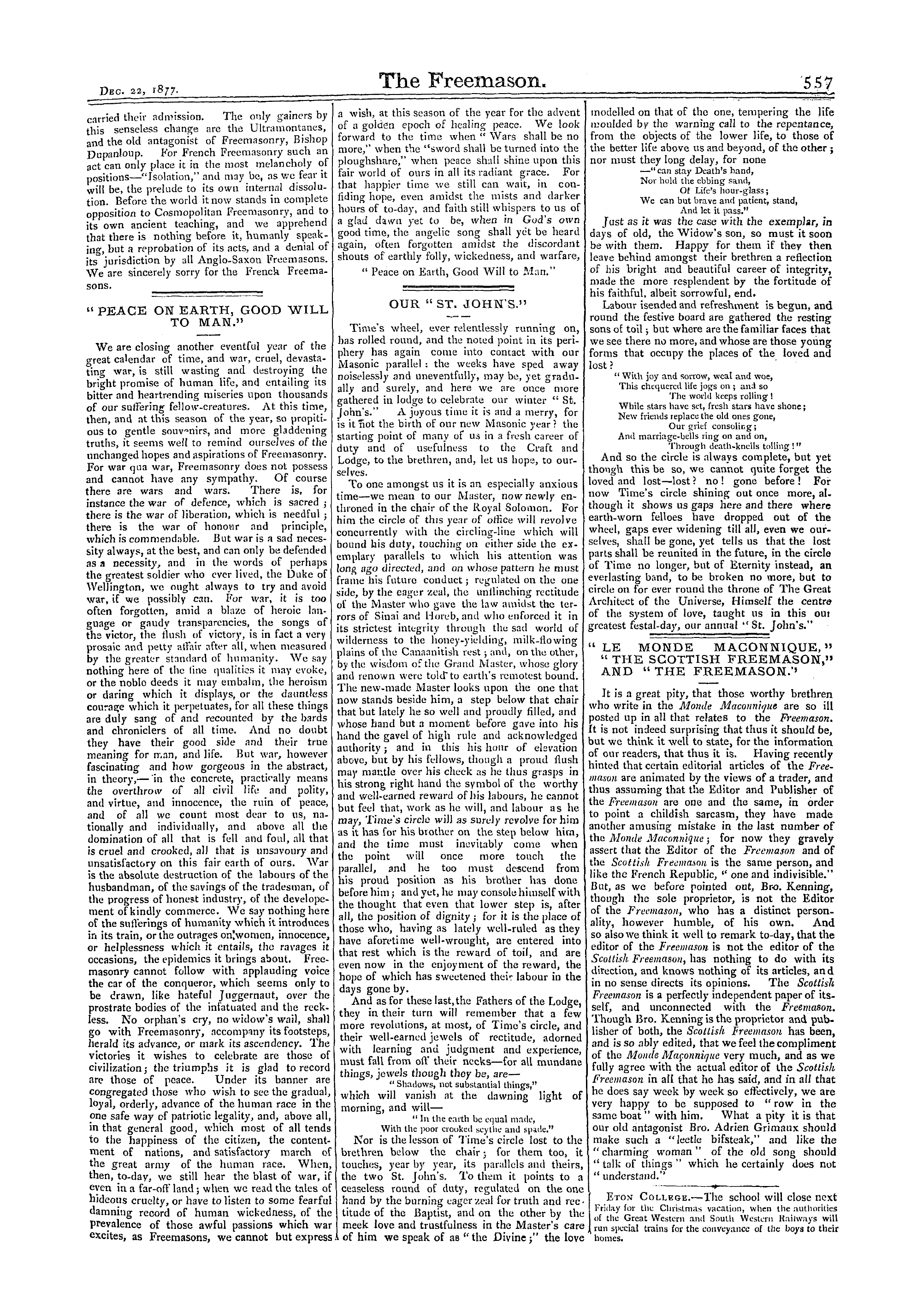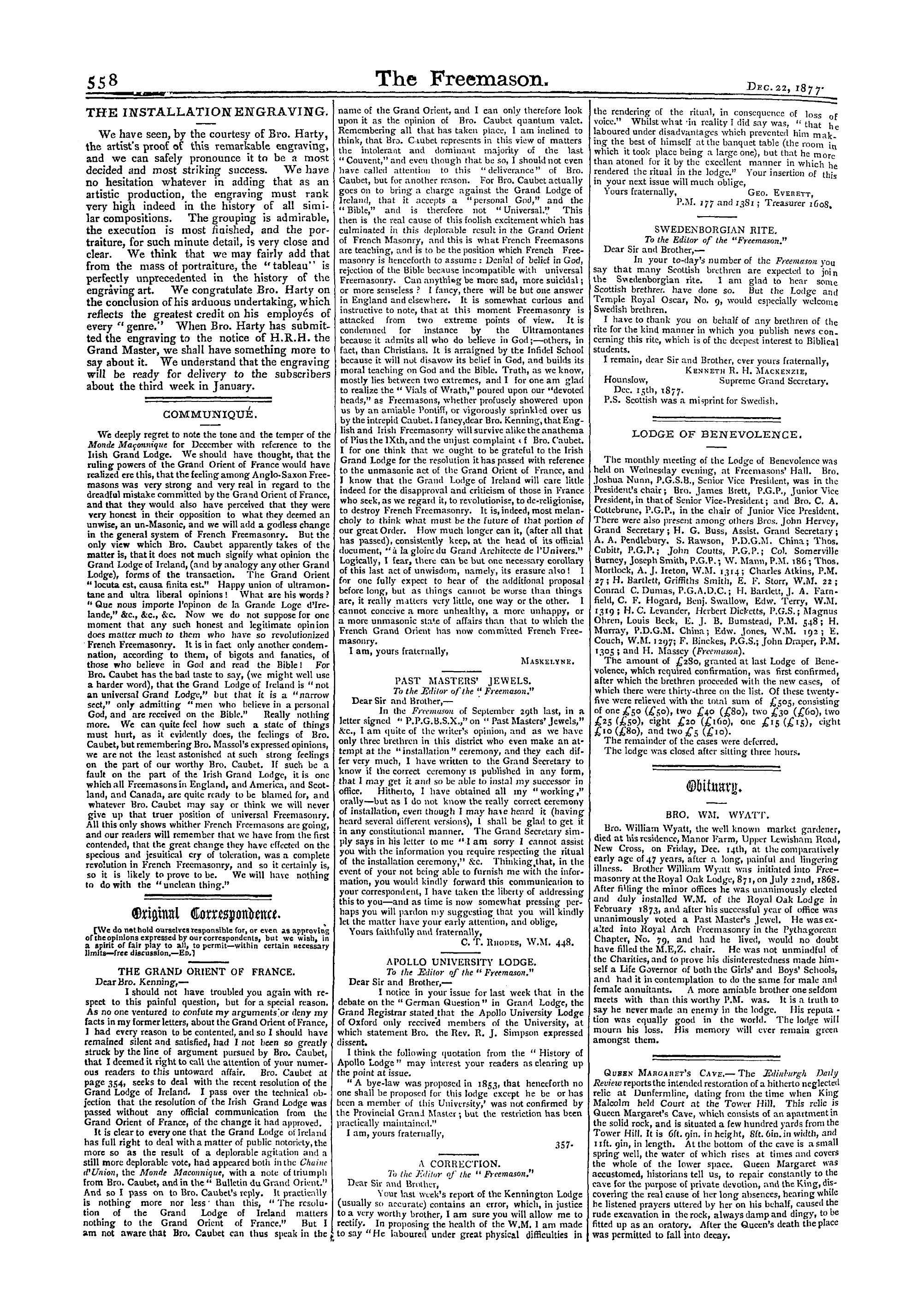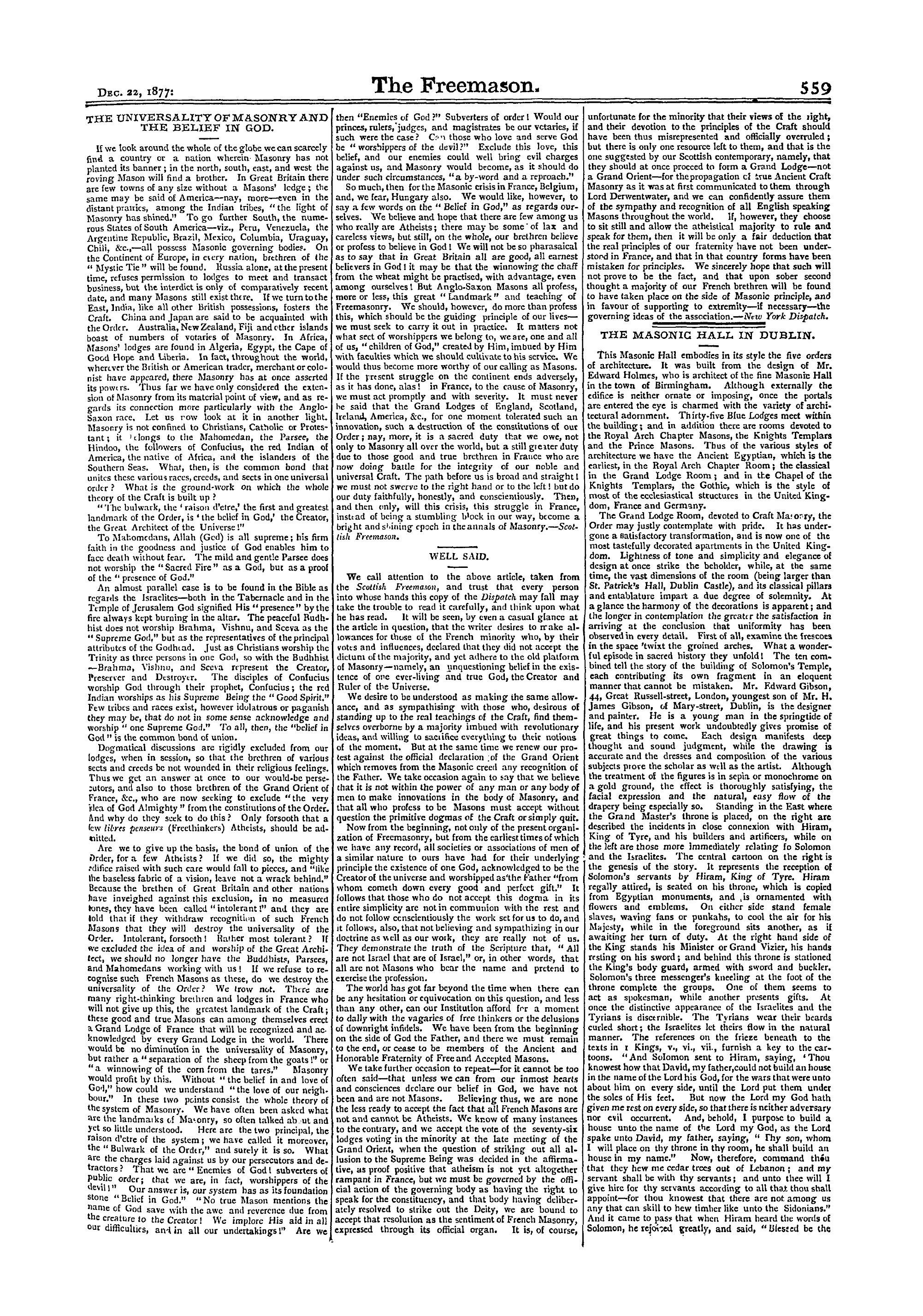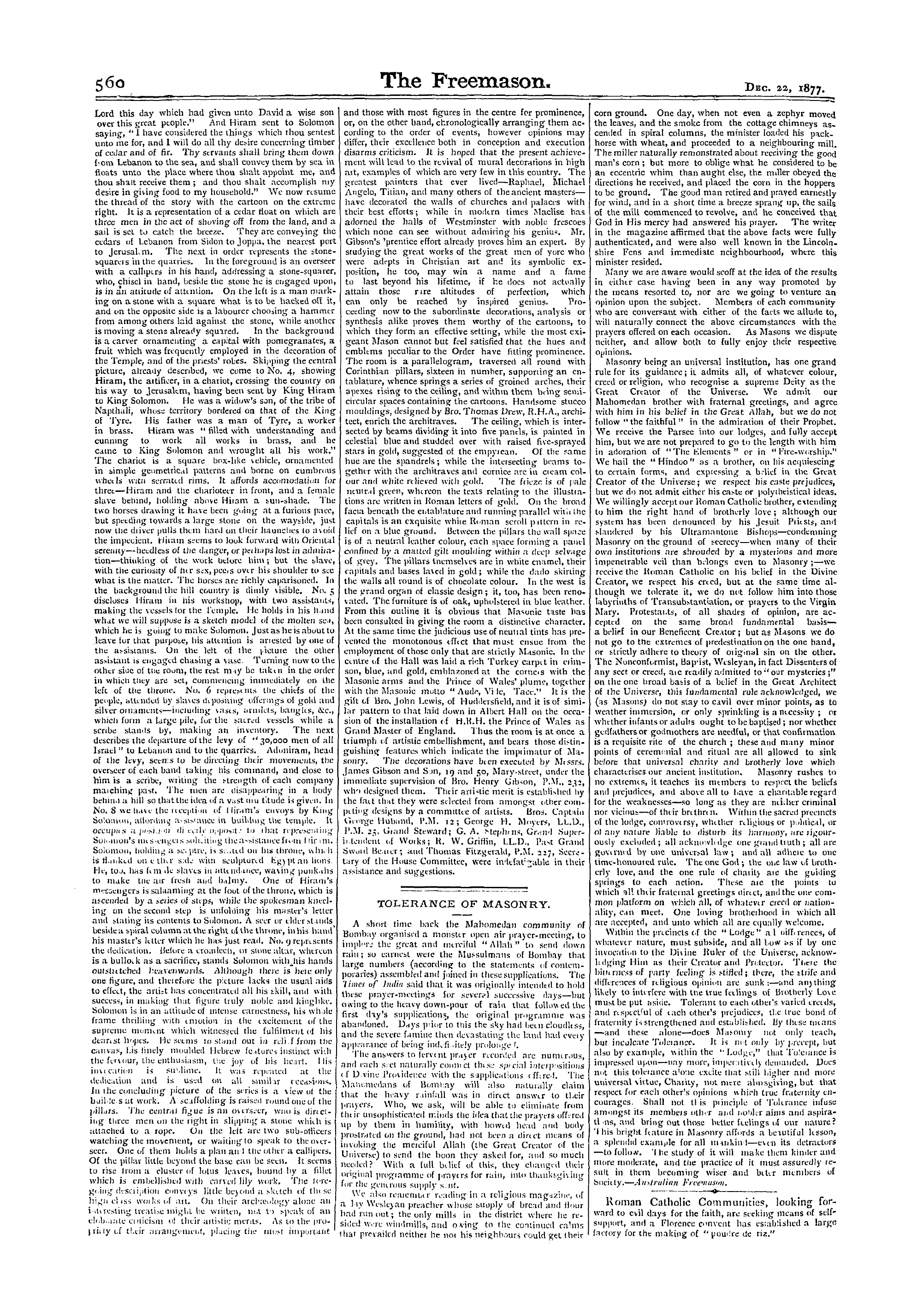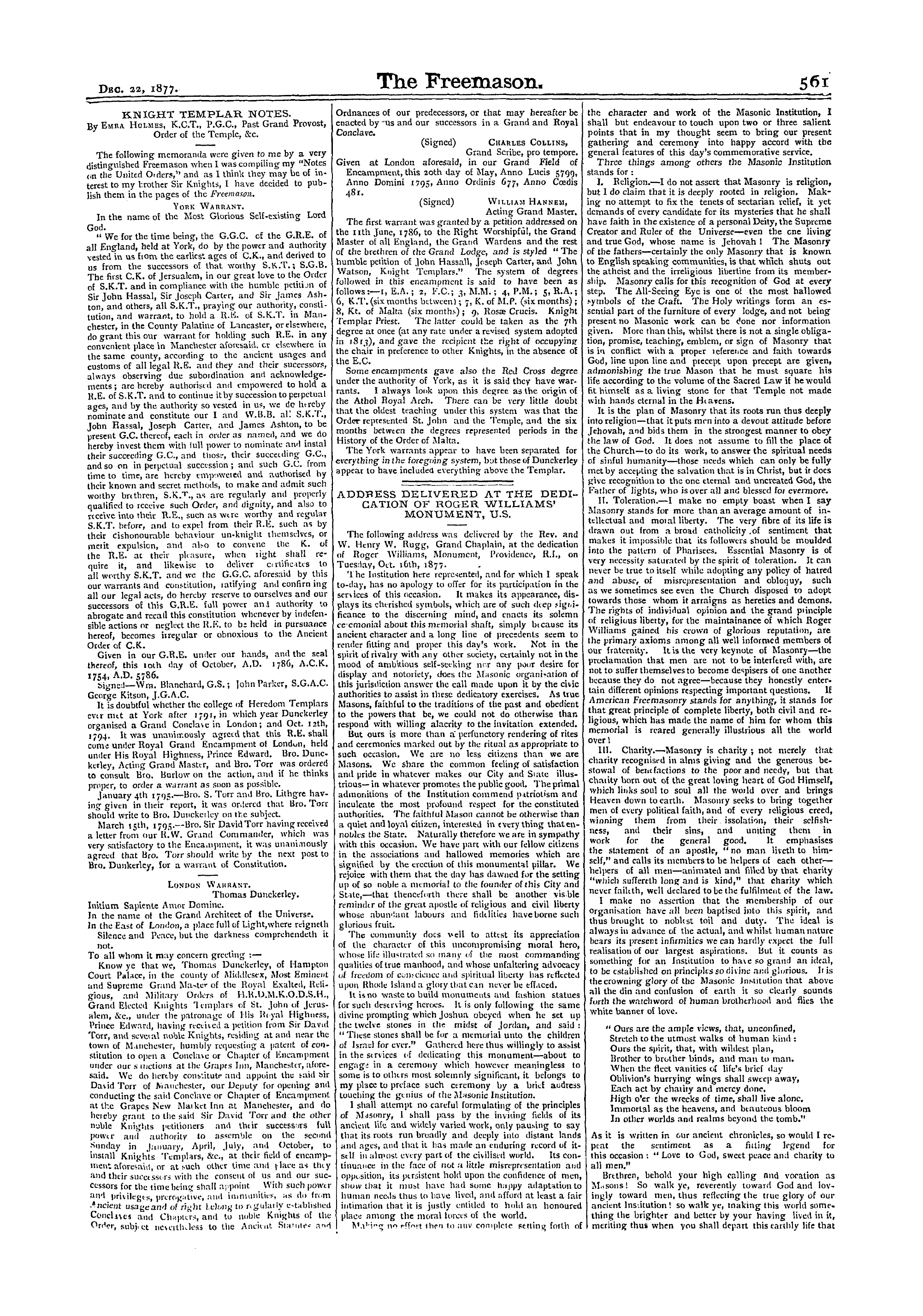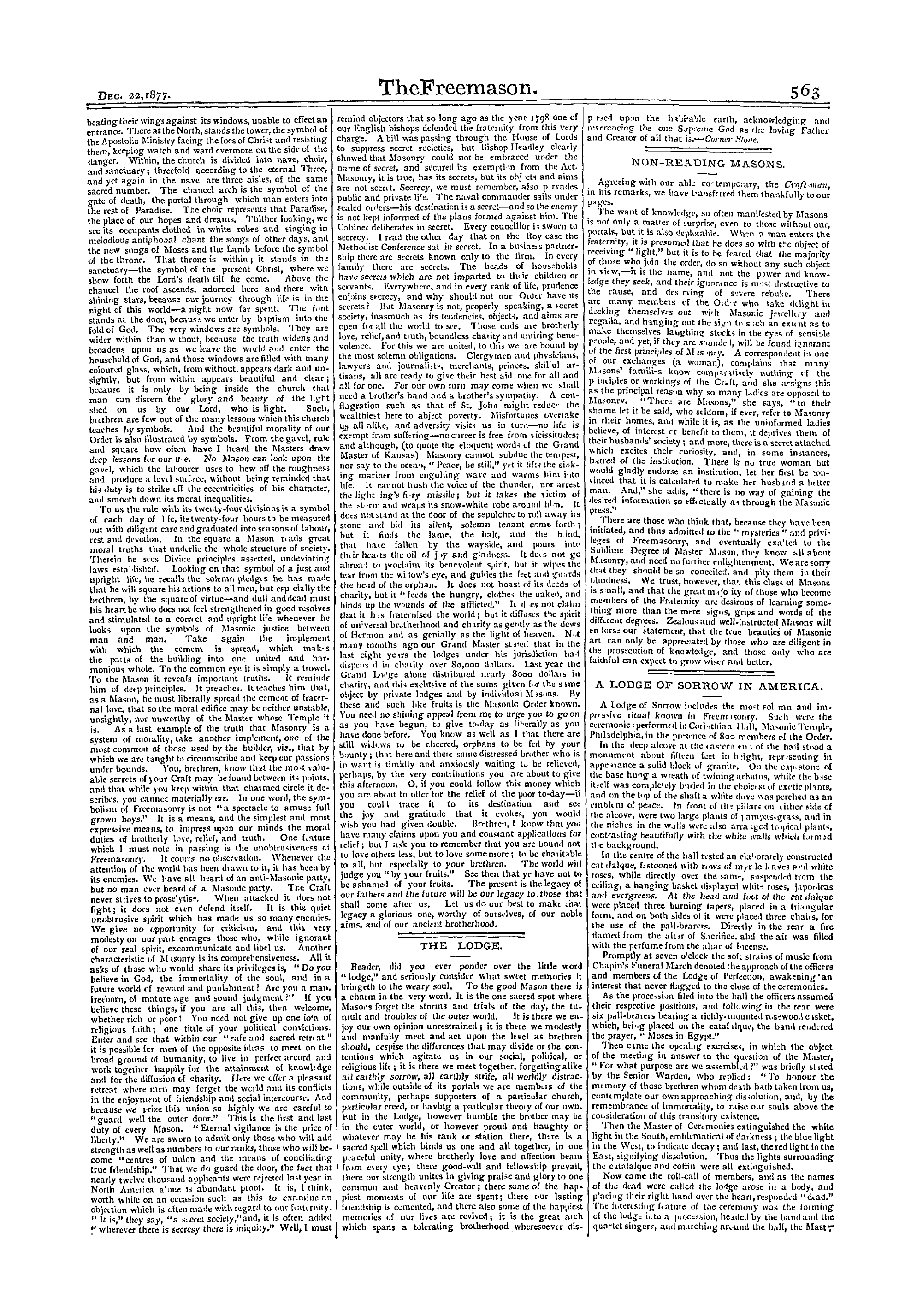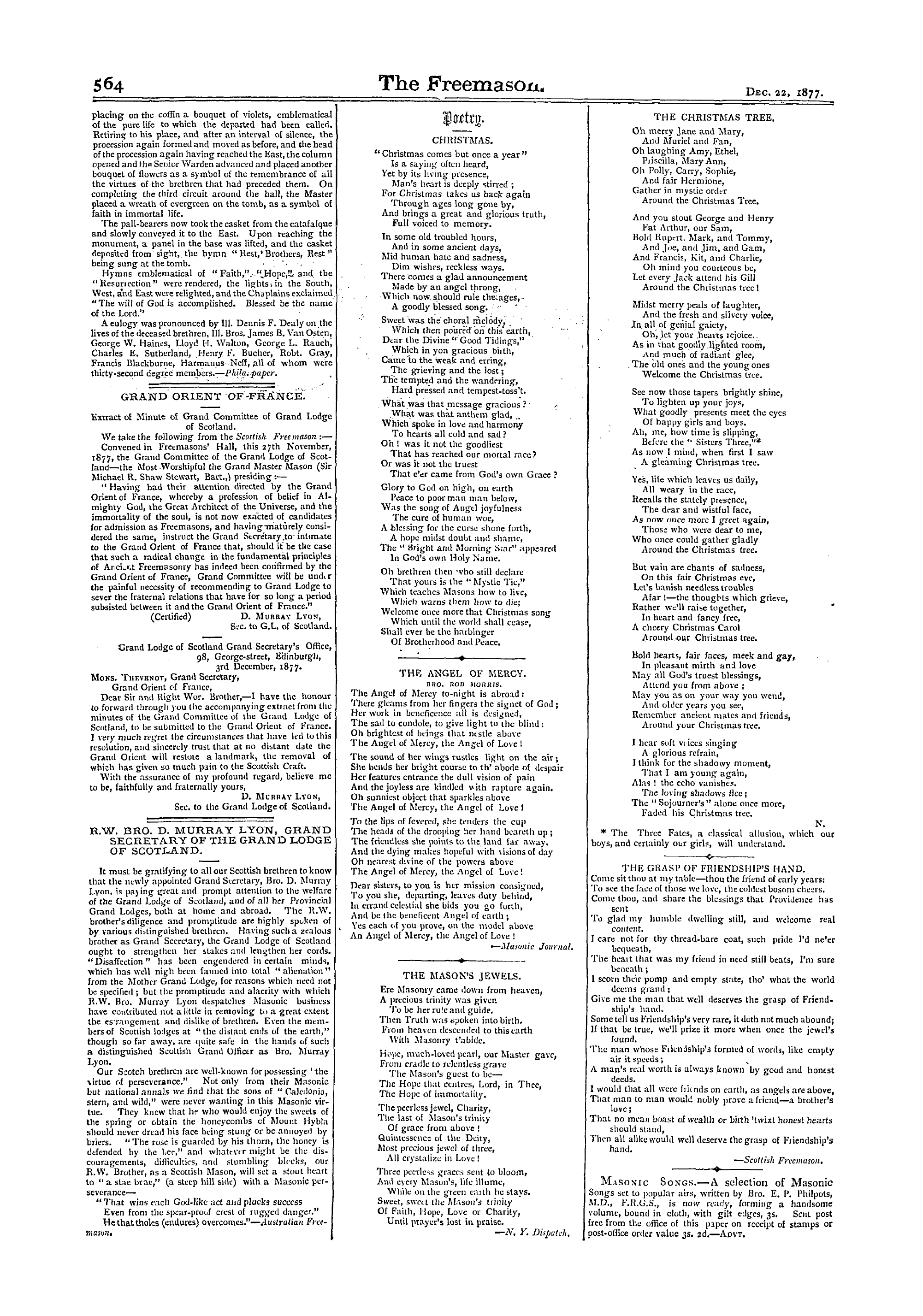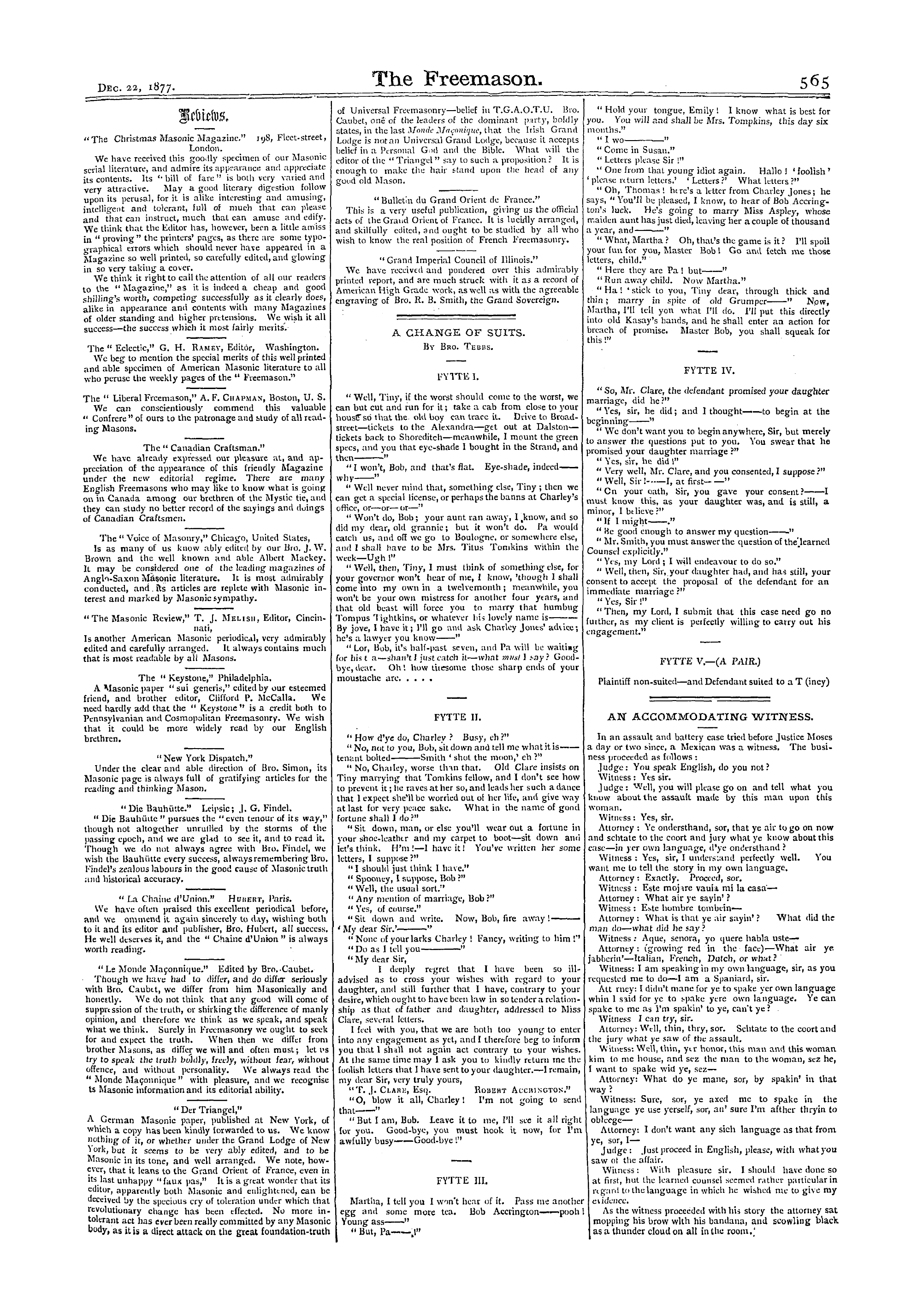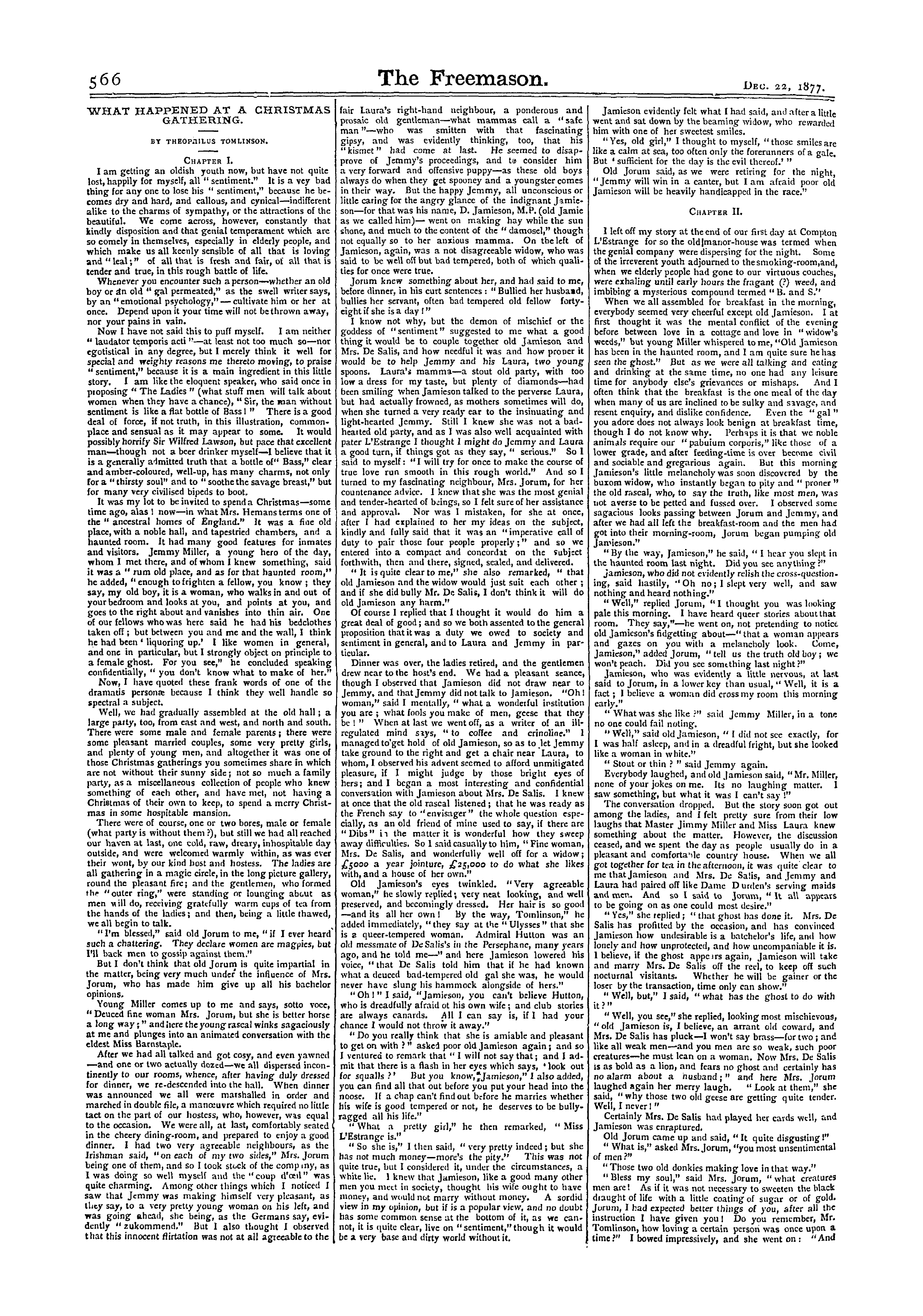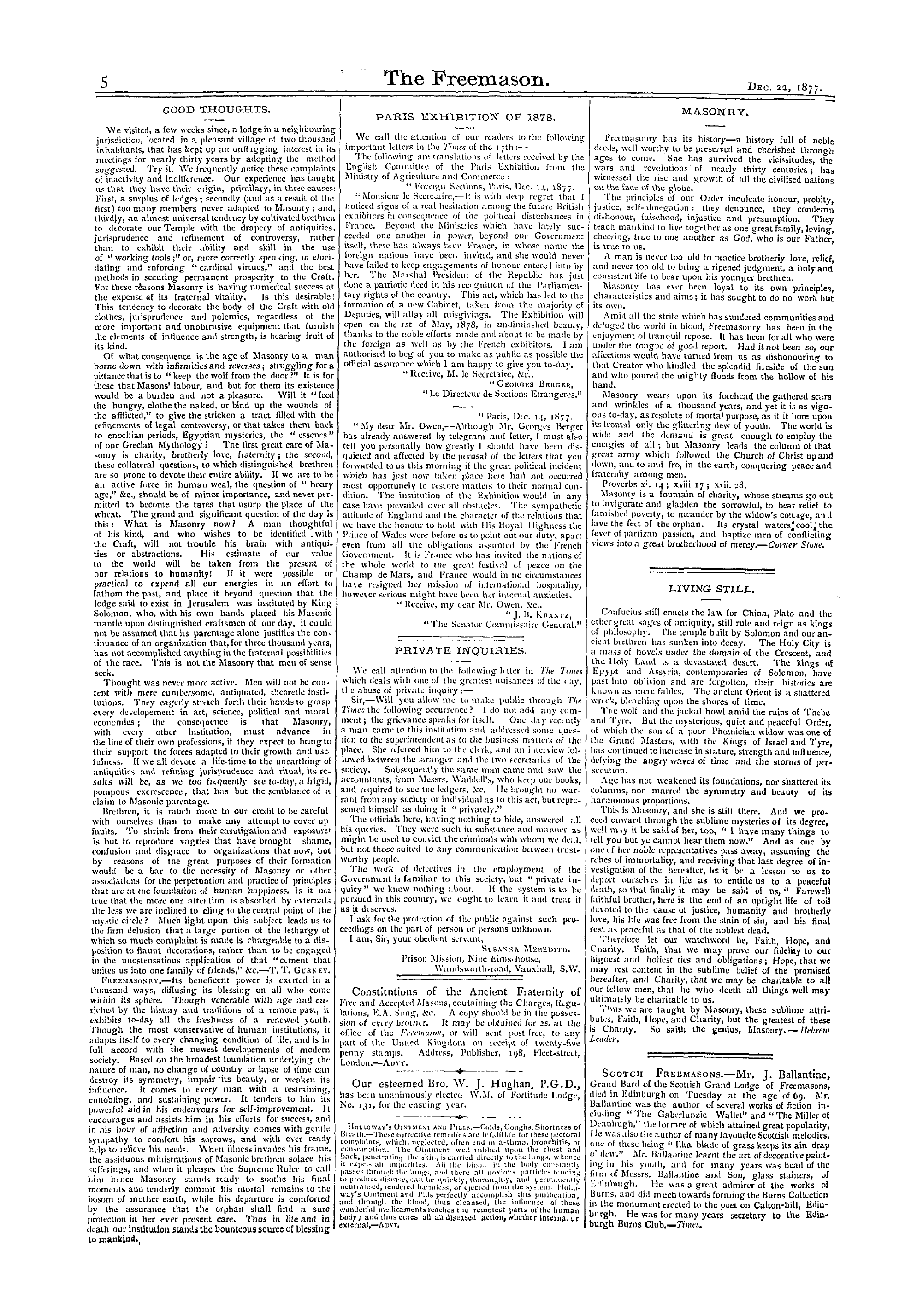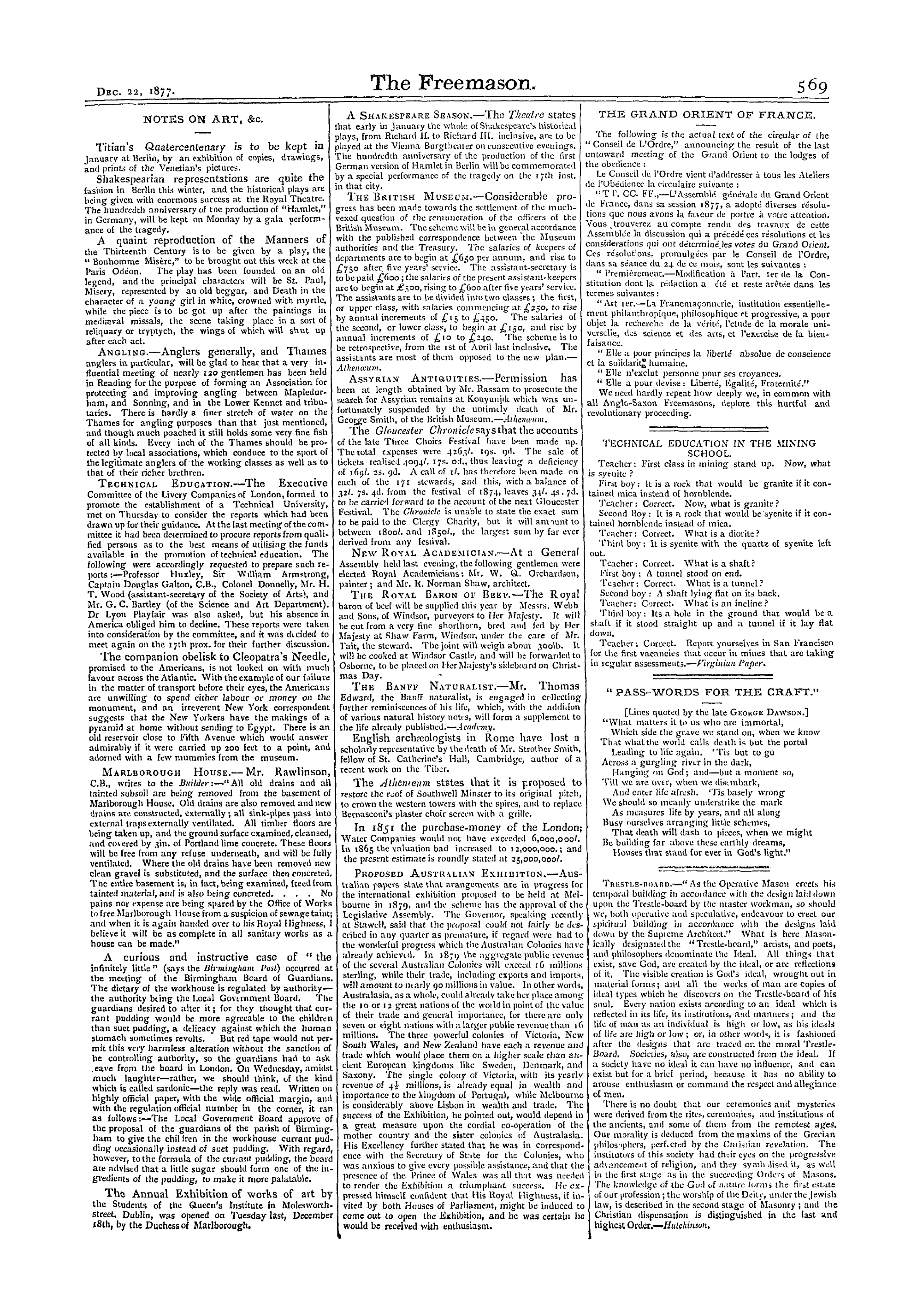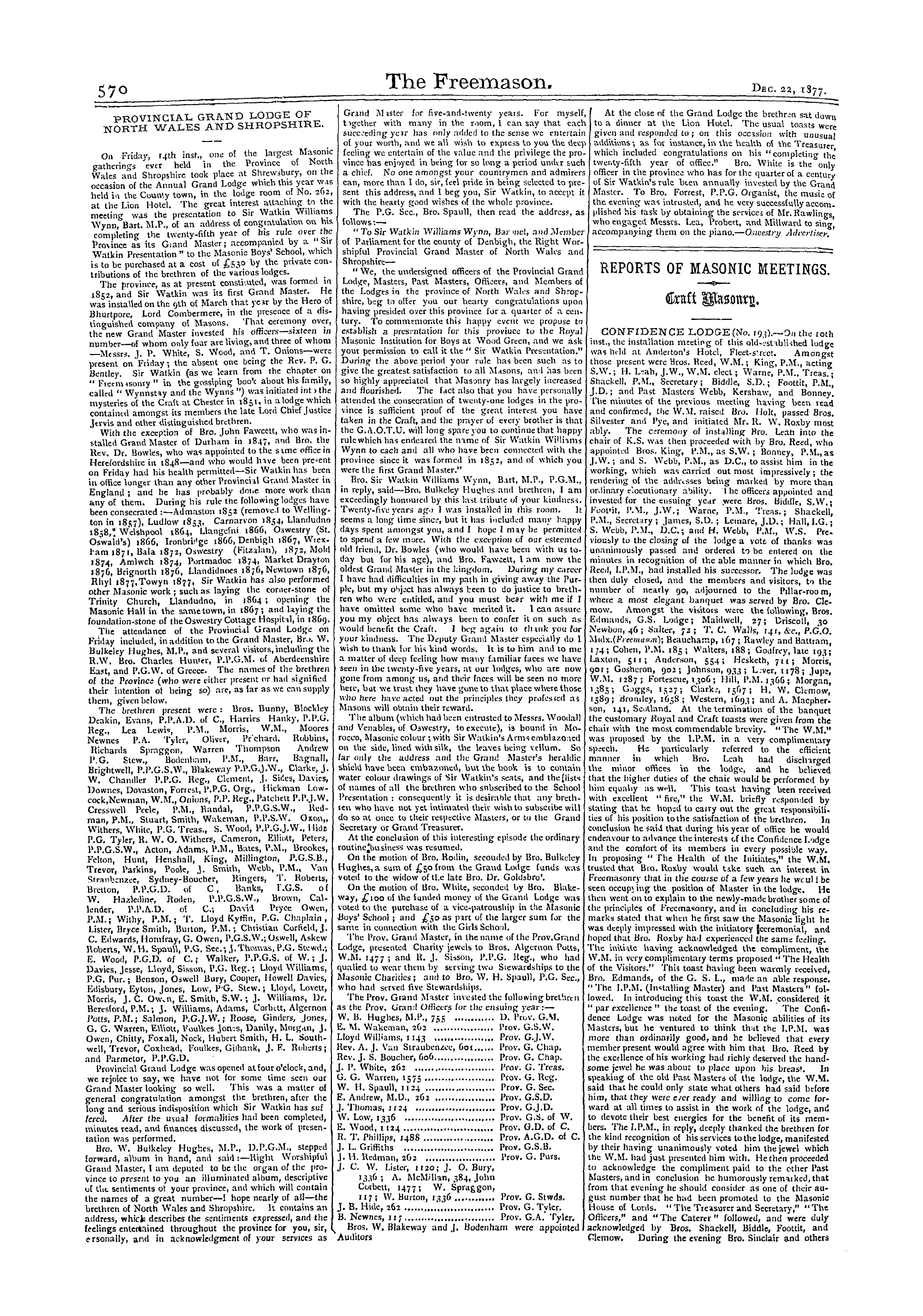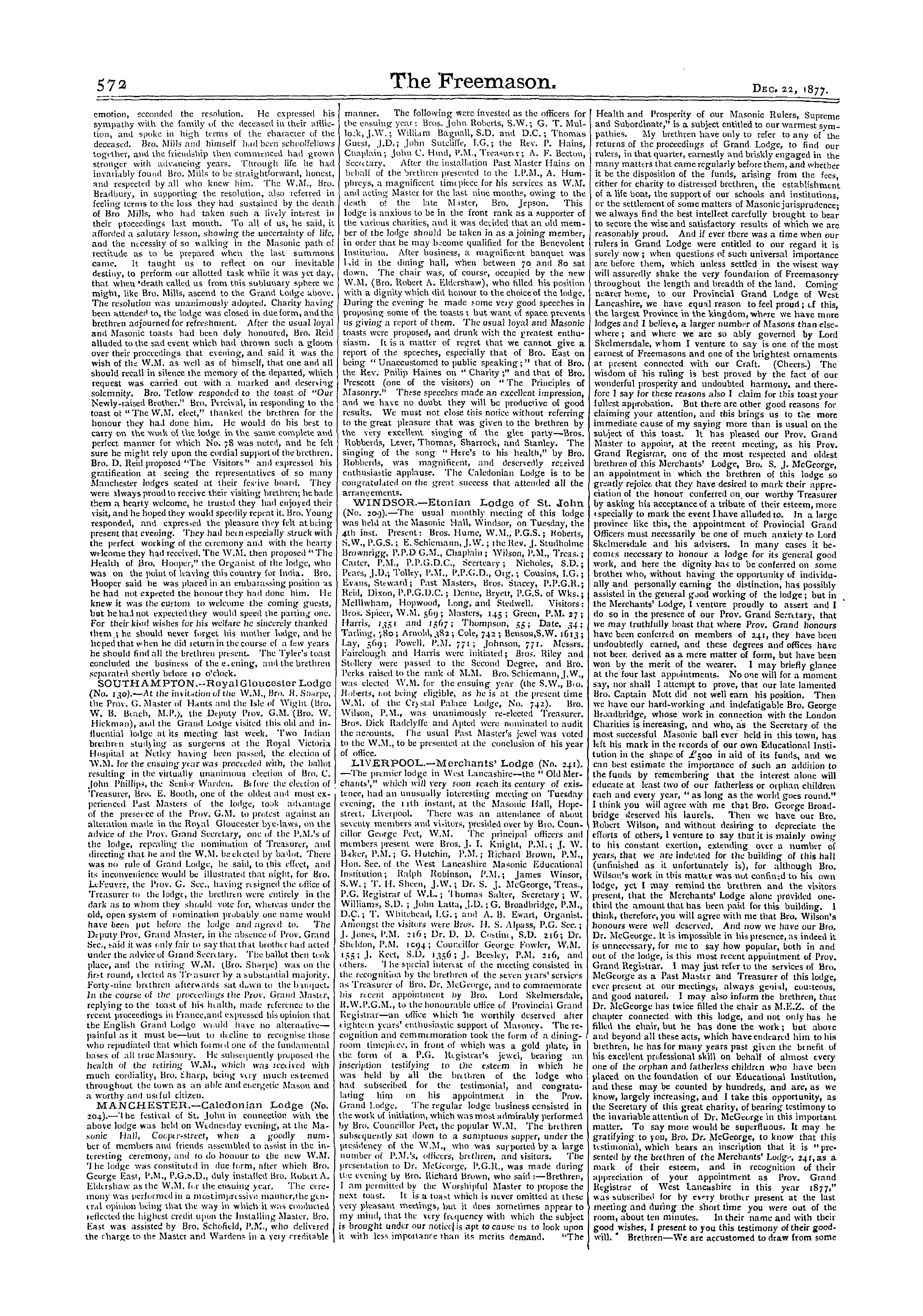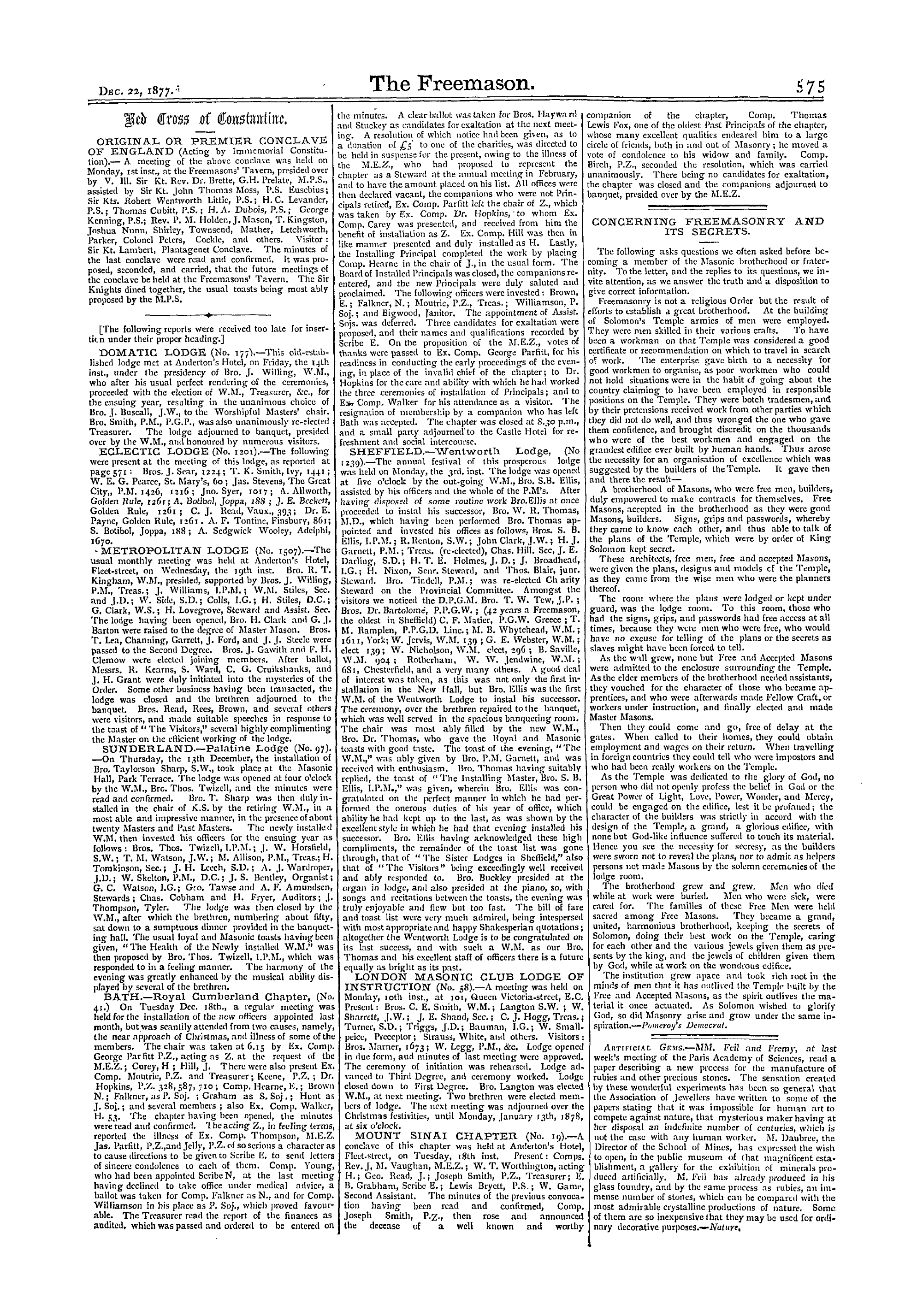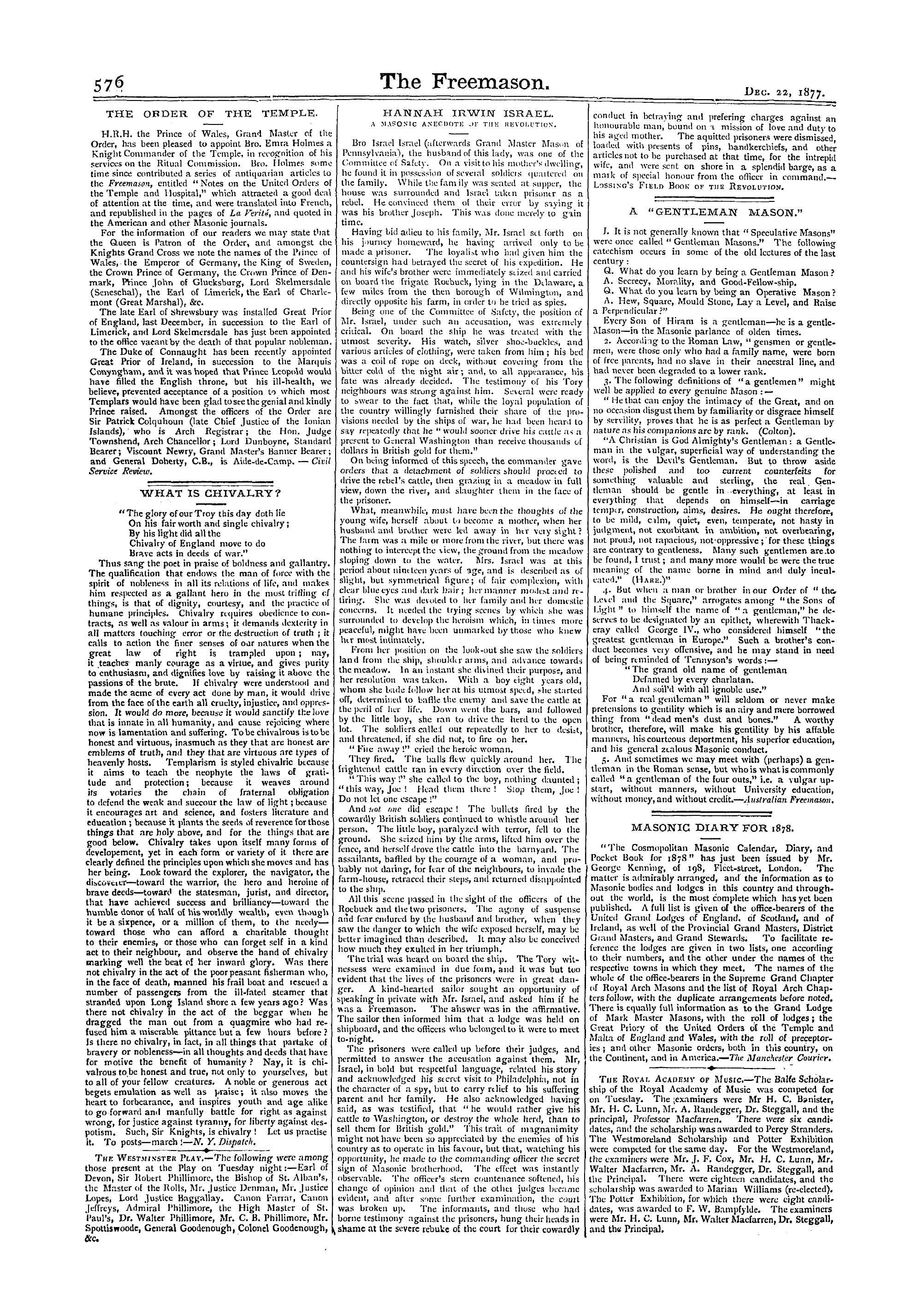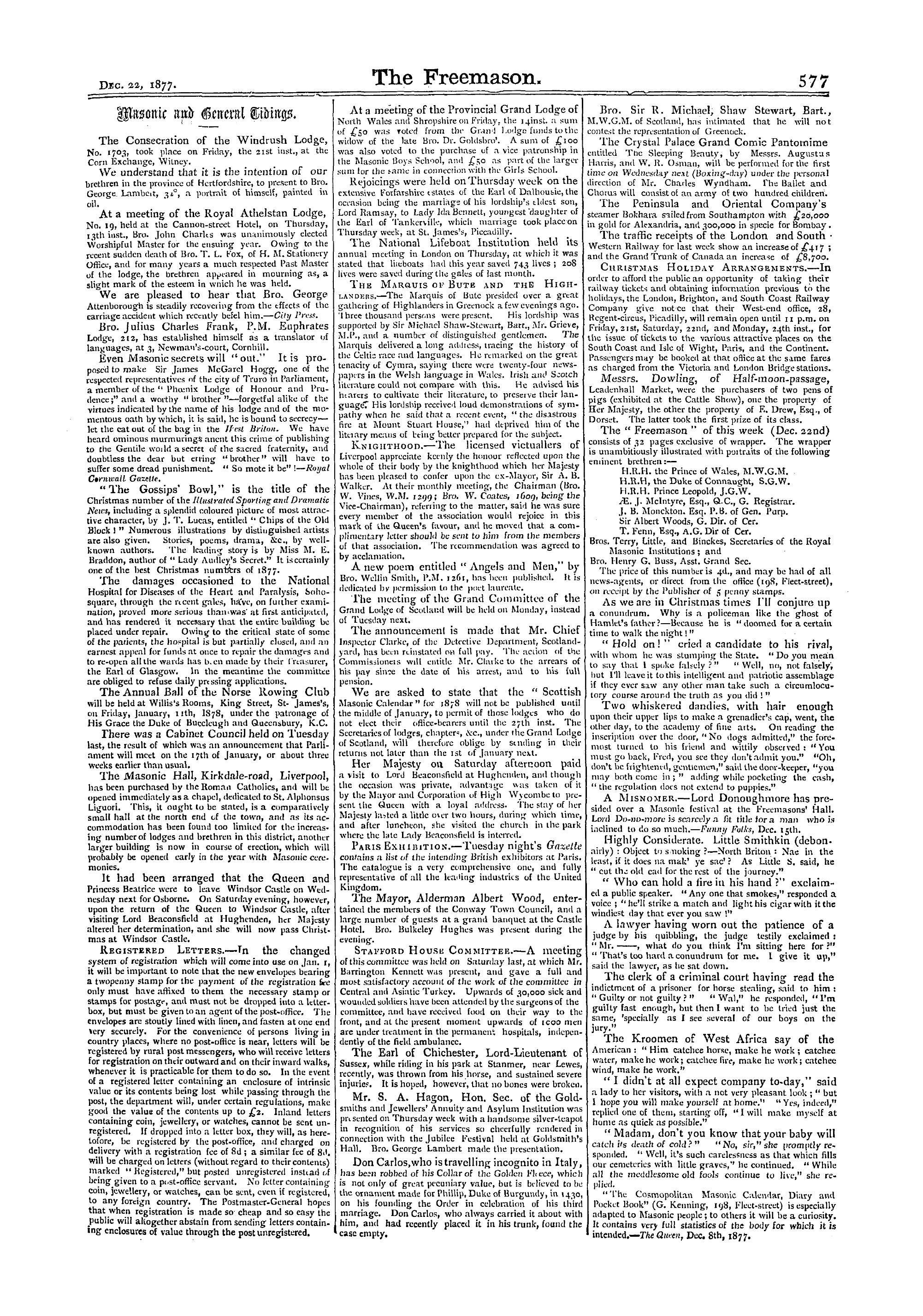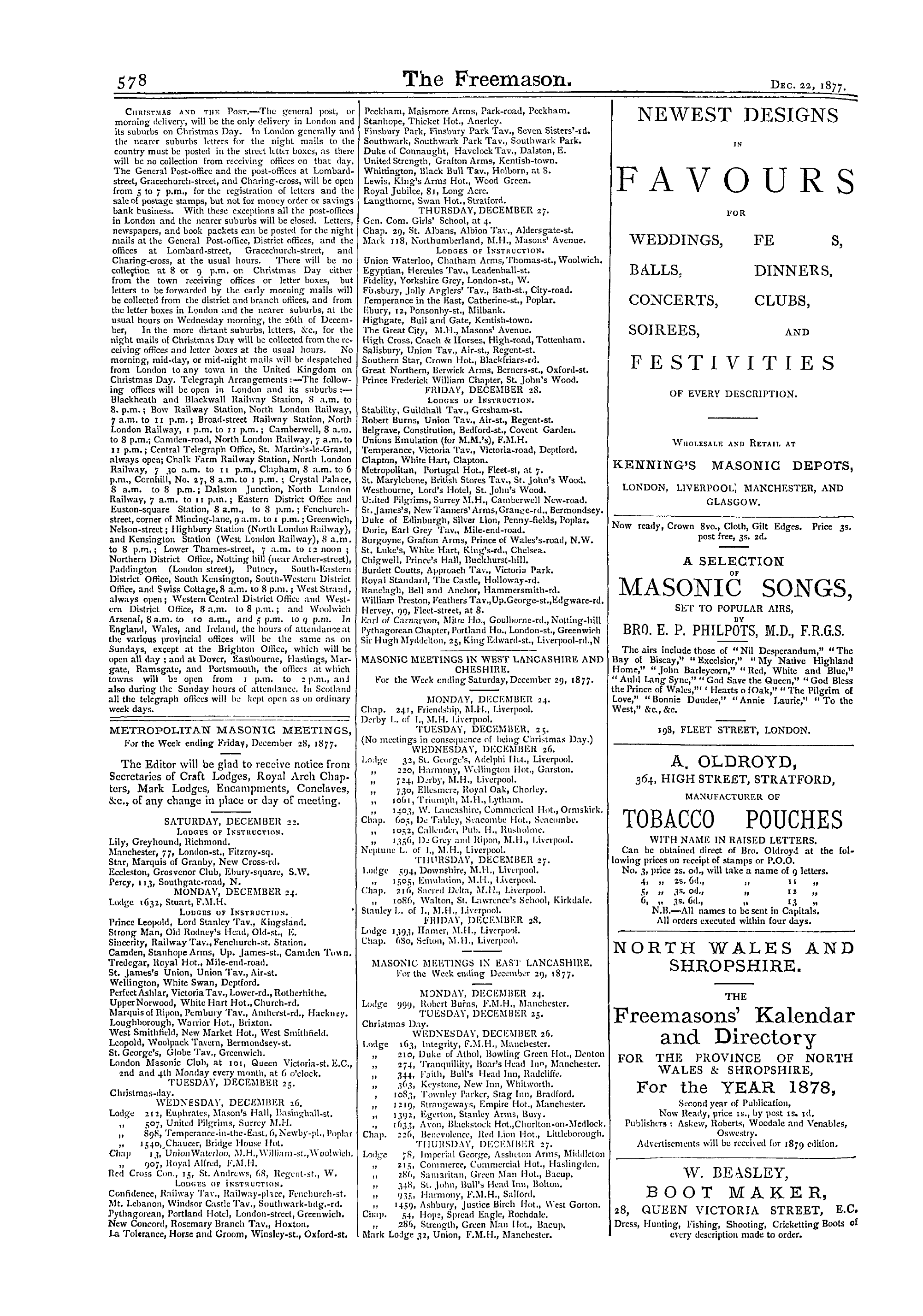-
Articles/Ads
Article THE MASONIC HALL IN DUBLIN. ← Page 2 of 2 Article THE MASONIC HALL IN DUBLIN. Page 2 of 2 Article TOLERANCE OF MASONRY. Page 1 of 1 Article TOLERANCE OF MASONRY. Page 1 of 1
Note: This text has been automatically extracted via Optical Character Recognition (OCR) software.
The Masonic Hall In Dublin.
Lord this day which had given unto David a wise son over this great people . " And Hiram sent to Solomon saying , "I have considered the things which thou sentest unto me for , and I will do all thy desire concerning timber of cedar and of fir . Thy servants shall bring them down f > om Lebanon to the sea , and shall convey them by sea in floats unto the place where thou shalt appoint me , and
thou shalt receive them ; and thou shalt accomplish my desire in giving food to my household . " We now resume the threaif of the story with the cartoon on the extreme right . It is a representation of a cedar float on which are three men in the act of shoving off from the land , and a sail is set to catch the breeze . They are conveying the cedars of Lebanon from Siclon to Joppa , the nearest port
to Jerusal . m . The next in order represents the stonesquarers in the quarries . In the foreground is an overseer with a callipers in his hand , addressing a stone-squarer , who , chisel in hand , bcsiile the stone he is engaged upon , is in an atlitude of attention . On the left is a man marking on a stone with a square what is to be hacked off it , and em the opposite siete is a labourer choosing a hammer
from among others laid against the stone , while another is moving a stons already squired . In the background is a carver ornamenting' a capital with pomegranates , a fruit which was frequently employed in the decoration of the Temple , and of the priests' robes . Skipping the central picture , already described , we come to No . 4 , showing Hiram , the artificer , in a chariot , crossing the country on his way to Jerusalem , having been sent by King Hiram
to King Solomon . He was a widow's son , of the tribe of Napthali , whose : territory bordered on that of the King of Tyre . His father was a man of Tyre , a worker in brass . Hiram was " filled with understanding and cunning to work all works in brass , and he came to King Solomon and wrought all his work . " The chariot is a square box-like vehicle , ornamented in simple geometrical patterns and borne on cumbrous wheels witn serrated rims . It affords accomodation for
three—Hiram and the charioteer in front , and a female slave behind , holding above Hiram a sun-shade . The two horses drawing it have been going at a furious pace , but speeding towards a large stone on the wayside , just now the driver pulls them hard on their haunches to avoid the impcuient . Hiiam stems to look forward vvitli Oriental serenity—heedless of the danger , or peihaps lost in
admiiation—thinking of the work belore him ; but the blavc , with the curiosity of her sex , peeis over his shoulder tei sec what is the matter . The horses are richly caparisoned . In the background the hill country is dimly visible . Ne > . 5 discloses Hiram in iiis workshop , with two assistants , making the vessels lor the Temple . He holds in his hand what we will suppose is a sketch model of the molten sea ,
which he is going to make Solomon . Just as he is about to leave lor that purpose , his attention is arrested by one of the assistants . On the kit of the licture the other assistant is engaged chasing a vase Turning now to the other siuc of tiic room , the rest m-iy be taken in the orelcr in which tliey are set , commencing immediately on the left of the throne-. No . 6 represents the chiefs of the
people , attended by skives tie positing offerings of gold and silver ornaments—including vases , armlets , bangles , iSc ., which form a large pile , for the sacred vessels while a scribe stands by , making an inventory . The next describes the departure of the levy e > f " 30 , 000 men of all Israel " to Lebanon and to the quarries . Aeluniram , head of the levy , sce-n : s to be directing their movements , the
overseer of each band taking his command , and close to him is a scribe , writing the strength of each company matching past . The men are disappearing in a body behind a hill so that the ielea eif a v . ist uiu tituele is g iven . In No . 8 wc have-the reception eif I dram ' s envoys by King Solomon , at'lorelim ; a-sis'tuvce in building the temple . It occupies a i »' . si . j in ili LVIIV opposit .- to ihat re-presenting
Soiwnon ' s ities-engcis sol kiting the assistance fio-m I tir mi . Solomon , holding a septic , is sc . iu . el 011 his throne , which is ti . inked uii tiller sale witn sculptured Egvpt an lions . He , too , has fe 111 ile slaves in nttenil . incc , waving punk . ills to make tne air fresh and balmy . One of Hiram's nr-ssengers is salaaming at the foot of the throne , which is ascender ! by a series of steps , while the spokesman
kneeling on the second step is unfolding his master's letter and slating its contents to Solomon . A seer e > r elder stands beside a spiral column at the right of tile throne , in his hand his master ' s letter which he has just read . No . 9 represents the dedication , lielore a cromlech , or stone altar , whereon is a bullo , k as a sacrifice , stands Solomon wiihjiis hands oulstietched heavenwards . Although there is belt only
one figure , and therefore the picture lacks the usual aids to effect , the artist lias concentrated all his skill , and with success , in making that figure truly noble ami kiuglike . Solomon is in an attitude of intense earnestness , his whole frame thrilling vvitli emotion in the excitement of the supreme moment which witnessed the fulfilment of his dennst hopes . He . seems to stand out in rtli . f from the
canvas , I . is finely moulded Hebrew features instinct vvi ' . li the fervour , the enthusiasm , ti : e joy of his heart . His inwcatit'ii is sitvlimc . It was repeated at the dedication and is useil on all similar ( ceasions . In the concluding picture of the series is a view ol the buil . lc . sat work . A scaffolding is raised round one of the pill . irs . The central fi » ue is an overseer , wnii is
directing three men on the right in slipping a stone which is attached to a rope . On the left are two sub-officers watching Ihe movement , or waiting ( o speak to the overseer . One of them holds a p lan an 1 the other a callipers . Of the pillar little beyonei the base can be seen . It seems to rise Iroin a cluster of lotus leaves , bound by a fillet
which is embellished will ) carved lily work . Die loregoing description conveys little be ) ond a sketch eif tin se lii r n e-1 is- ; woiks t'f ait . On their archaeology alone an i-iteresting treatise might he written , not to speak of an dob . ante cnlicism of their artistic merits . As to the-pro-( rieiycf tl . cir niiaiigeiiient , placing the most important
The Masonic Hall In Dublin.
and those with most figures m the centre for prominence , or , on the other hand , chronologically arranging them according to the order of events , however opinions may differ , their excellence both in conception and execution disarms criticism . It is hoped that the present achievement will lead to the revival of mural decorations in high art , examples of which are very few in this country . The
greatest painters that ever lived—Raphael , Michael Angelo , Titian , and many others of the ancient mastershave decorated the walls of churches anil palaces with their best efforts ; while in modern times Maclise has adorned the halls of Westminster with noble frescoes which none can see without admiring his genius . Mr . Gibson's ' prentice effort already proves him an expert . By
studying the great works of the great men of yore who were adepts in Christian art and its symbolic exposition , he too , may win a name and a fame to last beyond his lifetime , if he eloes not acteially attain those rire altitudes of perfection , which can only be reached by inspired genius . Proceeding now to the subonlinate tlecorations , analysis or
synthesis alike proves them worthy of the cartoons , to which they form an effective setting , while the most cxigeant Mason cannot but feel satisfied that the hues and emblems peculiar to the Order have fitting prominence . The room is a parallelogram , traversetl all round with Corinthian pillars , sixteen in number , supporting an entablature , whence springs a series of groined arches , their
apexes rising to the ceiling , and within them bring semicircular spaces containing the cartoons . Handsome stucco mouldings , designed by Bro . Thomas Drew , U . H . A ., architect , enrich the architraves . The ceiling , which is intersected by beams dividing it into five panels , is painted in celestial blue and studded over with raised five-sprayed stars in goltl , suggested of the empyrean . Of the fame
hue are the spandrels ; while the intersecting beams together with the architraves and cornice arc in cream colour and white relieved with gold . The frieze is of pale neutral green , whereon the texts relating to the illustiations are written in Roman letters of gold . On the broad facia beneath the entablature and running parallel vvitii ihe capitals is an exquisite while Reman scroll pit tern in
relief on . 1 blue ground . Between the pillars the wall space is of a neutral leather colour , each space forming a panel confined by a matted gilt moulding within a deep selvage of grey . The pillars tnemselves are in white enamel , their capitals and bases laved in gold ; while the dado skirling the walls all round is of chocolate colour . In the west is the grand organ of classic design ; it , too , has been
renovated . The furniture is of oak , upholstereel in blue leather . From this outline it is obvious that Masonic taste has been consulted in giving the room a distinctive character . At the same time the judicious use of neulial tints has prevented the monotonous effect that must ensue from the employment of those only that arc strictl y Masonic . In the centre tif the Hall was laid a rich Turkey carpet in
crimson , blue , and gold , emblazoned at the corneis with the Masonic arms and the Prince of Wales' plume , together with the Masonic motto " Audi ' , Vi Ic , Tace . " It is the gift of Bro . John Lewis , of Hudelersfield , and it is of similar pattern to that laid down in Albert Hall on the occasion of the installation of H . K . H . the Prince of Wales as Grand Master of England . Thus the room is at once a
triumph of artistic embellishment , and bears those distinguishing features which indicate the imprimatur of Masonry . The decorations have been executed by Messrs . James Gibson and Son , 19 and go , Mary-street , under the immediate supervision of Bro . Henry Gibson , P . M ., 232 , win designed them . Their arli-lic merit is established b y the fait that they were selected from amongst other
competing designs by a committee of artists . Bros . Captain George Huband , P . M . 12 ; George H . Moyers , LL . D ., P . M . 25 . Gianel Steward ; G . A . Meplnns , Grand Suprrii . teiiilciu of Woiks ; R . W . Griffin , LL . D .. Past Grand Swoid Be . ner ; and Thomas Fitzgerald , P . M . 227 , Secretary of the House Committee , were installable in their assistance and suggestions .
Tolerance Of Masonry.
TOLERANCE OF MASONRY .
A short time back the Mahomedan community of Bombay organised a monster open air prayer-meeting , to impl"i \; the great and merciful "Allah" to send down rain ; so earnest were the Mussulmans of Bombay that large numbers ( according to the statements of contemporaries ) assembled and joined in these supplications . The
7 IHICJ of India said that it was originally intended to hold these prayer-meetings for sever ?! successive days—but owing to the heavy down-pour of rain that followed the first day's supplications , the original programme was abandoned . Days prior to this the sky had been cloudless , and the severe famine then devastating the land had cvciy appearance of being intL-fi ., ite ! y prolonge ( .
The answers to fervent prayer rccimled are numerous , and i-ach s :-ct naturally count ct thi . se- special interpositions if D . vine Providence with the supplications iffirel . The Maiiomedans of Bombay will also naturally claim that the heavy rainfall was in dinct answer to tl . eir prayers . Who , we ask , will be able to eliminate from their unsophisticated minds the idea that the prayers off-. red
up by them m humility , with bowed head and body prostrated on the ground , had not been a direct means ol invoking the meieiful Allah ( the Great Creator of the Universe ) to send the boon they asked for , and so much needed ? With a full belief ot this , they changed their original programme of prayers for rain , into thanksgiving
for the generous supply s . lit . We also retneniur reading in a religious magazine , of a 1 iv We-slcyan preacher whose supply of bread and flour had run out ; the only mills in the district where he resided wvrc windmills , and oving to the continued ca ' ms that prevailed neither he 1101 his neighbours could get their
Tolerance Of Masonry.
corn ground . One day , when not even a zephyr moved the leaves , and the smoke from the cottage chimneys ascended in spiral columns , the minister loaded his packhorse with wheat , and proceeded to a neighbouring mill . The miller naturally remonstrated about receiving the good man's corn ; but more to oblige what he considered to be an eccentric whim than aught else , the miller obeyed the
directions he received , and placed the corn in the hoppers to be ground . The good man retired and prayed earnestl y for wind , and in a short time a breeze sprang up , the sails of the mill commenced to revolve , and he conceived that God in His mercy had answered his piayer . The writer in the magazine affirmed that the above facts were full y authenticated , and were also well known in the
Lincolnshire Fens and immediate neighbourhood , where this minister resided . Many we are aware would scoff at the idea of the results in either case having been in any way promoted by the means resorted to , nor are we going to venture an opinion upon the subject . Members of each community who are conversant with cither of the facts we allude to ,
will naturally connect the above circumstances with the prayers offered on each occasion . As Masons we dispute neither , and allow both to fully enjoy their respective opinions . Masonry being an universal institution , has one grand rule for its guidance ; it admits all , of whatever colour , creed or religion , who recognise a supreme Deity as the Great Creator of the Universe . We admit our
Mahomedan brother with fraternal greetings , and agree with him in his belief in the Great Allah , but we do not follow " the faithful " in the admiration of their Prophet . We receive the Parsee into our lodges , and fully accept him , but we are not prepared to go to the length with him in adoration of "The Elements " or in "Fire-worship . " We hail the "Hindoo" as a brother , on his acquiescing
to certain forms , and expressing a belief m the Great Creator of the Universe ; we respect his caste prejudices , but we do not admit either his caste or polytheistical ideas . We willingly accept our Roman Catholic brother , extending to him the right hand of brotherly love ; although our system has been denounced by his Jesuit Priests , and slandered by his Ultramnntone Bishops—condemning
Masonry on the ground of secrecy—when many of their own institutions are shrouded by a mysterious and more impenetrable veil than belongs even to Masonry ;—we receive the Roman Catholic on his belief in the Divine Creator , we respect his creed , but at the same time although we tolerate it , we do not follow him into those labyrinths of Transubstantiation , or prayers to the Virgin
Mary . Protestai . ts , of all shades of opinion , are accepted on the same broael fundamental basisa belief in our Beneficent Creator ; but as Masons wc do not go to the extremes of predestination on the one hand , or strictly adhere to theory of original sin on the other . The Nonconformist , Bap'ist , Weslcyan , in fact Dissenters of any sect or creed , are readily admitted to ¦ ' our mysteries : "
on the one broad basis of a belief in the Gieat Architect of the Universe , this fundamental rule acknowledged , we ( as Masons ) do not stay to cavil over minor points , as to weather immersion , or only sprinkling is a necessity ; or whether infants or adults ought to be baptised ; nor whether gedfathers or godmothers are needful , or that confirmation is a requisite rite of the church ; these and many minor
points of ceremonial and ritual are all allowed to sink before that universal charity and brotherly love which characterises our ancient institution . Masonry rushes to no extremis , it teaches its members to respect the beliefs and prejudices , and above all to have a charitable regard for the weaknesses—so long as they are neither criminal nor vicious—of their brethre n . Within the sacred precincts
of the lodge , controversy , whether religious or political , or ot any nature liable to disturb its harmony , are rigourously excluded ; all acknowledge one giand truth ; all are governed by one universal law ; and all ailhcie to one time-honoured rule . The one God ; the one law e-f brotherly love , and the one rule of charity aic the guiding springs to each action . These are the points lu
which 9 l ! their fraternal greetings ilinct , and the one common platform on which all , of whatever creed or nationality , can meet . One loving brothcihood in which all are accepted , and unto which all arc equally welcome . Within the precincts of the " Lodge" a 1 differences , of whatever nature , must subside , and all bow as if by one invocation to the Divine Ruler of the Universe ,
acknowledging Him as their Creator and Protector . Tlecie the biiierne'ss of party feeling is stifled j there ' , the strife and differences of religious opinion are sunk : —and anj thing likely to interfere with tlie true feelings of Brotherly Love must be put aside . Tolerant to each other's varied creeds , and respectful of each other's prejudices , tie true bond of fraternity is strengthened and established . By these- means
—and these alone—does Masoniy not only teach , but inculcate Toleiance . It is ml only by precept , but also by example , within the "Lodge , " that Toleiance is impressed upon—nay more , impeiitively demanded . Does not this toleiance a ' o-. ic excite that still higher and more universal virtue , Charity , not mere almsgiving , but that respect for each other ' s opinions vvhirh true fraternity encourages . Shall not tl is principle of Tolerance infuse
amongst its mcmbeis other and iiobh-r aims and aspiratl > ns , and bring out those bitter feelings of our nature ? 'I his bright feature in Masonry affords a beiutiful lesson , a splendid example for all nunkinl—even its detractors —to follo-v . 'I he study of it will make them kinder and more moderate , and the practice of it must assuredly result in them he-coming wiser and beter members of bocitty . —Australian Frt'e'iiasmi .
Roman Catholic Communities , looking forward to evil days for the faith , are seeking means of selfsupport , anil a Florence convent has established a large factory for the making of " poudre de riz . "
Note: This text has been automatically extracted via Optical Character Recognition (OCR) software.
The Masonic Hall In Dublin.
Lord this day which had given unto David a wise son over this great people . " And Hiram sent to Solomon saying , "I have considered the things which thou sentest unto me for , and I will do all thy desire concerning timber of cedar and of fir . Thy servants shall bring them down f > om Lebanon to the sea , and shall convey them by sea in floats unto the place where thou shalt appoint me , and
thou shalt receive them ; and thou shalt accomplish my desire in giving food to my household . " We now resume the threaif of the story with the cartoon on the extreme right . It is a representation of a cedar float on which are three men in the act of shoving off from the land , and a sail is set to catch the breeze . They are conveying the cedars of Lebanon from Siclon to Joppa , the nearest port
to Jerusal . m . The next in order represents the stonesquarers in the quarries . In the foreground is an overseer with a callipers in his hand , addressing a stone-squarer , who , chisel in hand , bcsiile the stone he is engaged upon , is in an atlitude of attention . On the left is a man marking on a stone with a square what is to be hacked off it , and em the opposite siete is a labourer choosing a hammer
from among others laid against the stone , while another is moving a stons already squired . In the background is a carver ornamenting' a capital with pomegranates , a fruit which was frequently employed in the decoration of the Temple , and of the priests' robes . Skipping the central picture , already described , we come to No . 4 , showing Hiram , the artificer , in a chariot , crossing the country on his way to Jerusalem , having been sent by King Hiram
to King Solomon . He was a widow's son , of the tribe of Napthali , whose : territory bordered on that of the King of Tyre . His father was a man of Tyre , a worker in brass . Hiram was " filled with understanding and cunning to work all works in brass , and he came to King Solomon and wrought all his work . " The chariot is a square box-like vehicle , ornamented in simple geometrical patterns and borne on cumbrous wheels witn serrated rims . It affords accomodation for
three—Hiram and the charioteer in front , and a female slave behind , holding above Hiram a sun-shade . The two horses drawing it have been going at a furious pace , but speeding towards a large stone on the wayside , just now the driver pulls them hard on their haunches to avoid the impcuient . Hiiam stems to look forward vvitli Oriental serenity—heedless of the danger , or peihaps lost in
admiiation—thinking of the work belore him ; but the blavc , with the curiosity of her sex , peeis over his shoulder tei sec what is the matter . The horses are richly caparisoned . In the background the hill country is dimly visible . Ne > . 5 discloses Hiram in iiis workshop , with two assistants , making the vessels lor the Temple . He holds in his hand what we will suppose is a sketch model of the molten sea ,
which he is going to make Solomon . Just as he is about to leave lor that purpose , his attention is arrested by one of the assistants . On the kit of the licture the other assistant is engaged chasing a vase Turning now to the other siuc of tiic room , the rest m-iy be taken in the orelcr in which tliey are set , commencing immediately on the left of the throne-. No . 6 represents the chiefs of the
people , attended by skives tie positing offerings of gold and silver ornaments—including vases , armlets , bangles , iSc ., which form a large pile , for the sacred vessels while a scribe stands by , making an inventory . The next describes the departure of the levy e > f " 30 , 000 men of all Israel " to Lebanon and to the quarries . Aeluniram , head of the levy , sce-n : s to be directing their movements , the
overseer of each band taking his command , and close to him is a scribe , writing the strength of each company matching past . The men are disappearing in a body behind a hill so that the ielea eif a v . ist uiu tituele is g iven . In No . 8 wc have-the reception eif I dram ' s envoys by King Solomon , at'lorelim ; a-sis'tuvce in building the temple . It occupies a i »' . si . j in ili LVIIV opposit .- to ihat re-presenting
Soiwnon ' s ities-engcis sol kiting the assistance fio-m I tir mi . Solomon , holding a septic , is sc . iu . el 011 his throne , which is ti . inked uii tiller sale witn sculptured Egvpt an lions . He , too , has fe 111 ile slaves in nttenil . incc , waving punk . ills to make tne air fresh and balmy . One of Hiram's nr-ssengers is salaaming at the foot of the throne , which is ascender ! by a series of steps , while the spokesman
kneeling on the second step is unfolding his master's letter and slating its contents to Solomon . A seer e > r elder stands beside a spiral column at the right of tile throne , in his hand his master ' s letter which he has just read . No . 9 represents the dedication , lielore a cromlech , or stone altar , whereon is a bullo , k as a sacrifice , stands Solomon wiihjiis hands oulstietched heavenwards . Although there is belt only
one figure , and therefore the picture lacks the usual aids to effect , the artist lias concentrated all his skill , and with success , in making that figure truly noble ami kiuglike . Solomon is in an attitude of intense earnestness , his whole frame thrilling vvitli emotion in the excitement of the supreme moment which witnessed the fulfilment of his dennst hopes . He . seems to stand out in rtli . f from the
canvas , I . is finely moulded Hebrew features instinct vvi ' . li the fervour , the enthusiasm , ti : e joy of his heart . His inwcatit'ii is sitvlimc . It was repeated at the dedication and is useil on all similar ( ceasions . In the concluding picture of the series is a view ol the buil . lc . sat work . A scaffolding is raised round one of the pill . irs . The central fi » ue is an overseer , wnii is
directing three men on the right in slipping a stone which is attached to a rope . On the left are two sub-officers watching Ihe movement , or waiting ( o speak to the overseer . One of them holds a p lan an 1 the other a callipers . Of the pillar little beyonei the base can be seen . It seems to rise Iroin a cluster of lotus leaves , bound by a fillet
which is embellished will ) carved lily work . Die loregoing description conveys little be ) ond a sketch eif tin se lii r n e-1 is- ; woiks t'f ait . On their archaeology alone an i-iteresting treatise might he written , not to speak of an dob . ante cnlicism of their artistic merits . As to the-pro-( rieiycf tl . cir niiaiigeiiient , placing the most important
The Masonic Hall In Dublin.
and those with most figures m the centre for prominence , or , on the other hand , chronologically arranging them according to the order of events , however opinions may differ , their excellence both in conception and execution disarms criticism . It is hoped that the present achievement will lead to the revival of mural decorations in high art , examples of which are very few in this country . The
greatest painters that ever lived—Raphael , Michael Angelo , Titian , and many others of the ancient mastershave decorated the walls of churches anil palaces with their best efforts ; while in modern times Maclise has adorned the halls of Westminster with noble frescoes which none can see without admiring his genius . Mr . Gibson's ' prentice effort already proves him an expert . By
studying the great works of the great men of yore who were adepts in Christian art and its symbolic exposition , he too , may win a name and a fame to last beyond his lifetime , if he eloes not acteially attain those rire altitudes of perfection , which can only be reached by inspired genius . Proceeding now to the subonlinate tlecorations , analysis or
synthesis alike proves them worthy of the cartoons , to which they form an effective setting , while the most cxigeant Mason cannot but feel satisfied that the hues and emblems peculiar to the Order have fitting prominence . The room is a parallelogram , traversetl all round with Corinthian pillars , sixteen in number , supporting an entablature , whence springs a series of groined arches , their
apexes rising to the ceiling , and within them bring semicircular spaces containing the cartoons . Handsome stucco mouldings , designed by Bro . Thomas Drew , U . H . A ., architect , enrich the architraves . The ceiling , which is intersected by beams dividing it into five panels , is painted in celestial blue and studded over with raised five-sprayed stars in goltl , suggested of the empyrean . Of the fame
hue are the spandrels ; while the intersecting beams together with the architraves and cornice arc in cream colour and white relieved with gold . The frieze is of pale neutral green , whereon the texts relating to the illustiations are written in Roman letters of gold . On the broad facia beneath the entablature and running parallel vvitii ihe capitals is an exquisite while Reman scroll pit tern in
relief on . 1 blue ground . Between the pillars the wall space is of a neutral leather colour , each space forming a panel confined by a matted gilt moulding within a deep selvage of grey . The pillars tnemselves are in white enamel , their capitals and bases laved in gold ; while the dado skirling the walls all round is of chocolate colour . In the west is the grand organ of classic design ; it , too , has been
renovated . The furniture is of oak , upholstereel in blue leather . From this outline it is obvious that Masonic taste has been consulted in giving the room a distinctive character . At the same time the judicious use of neulial tints has prevented the monotonous effect that must ensue from the employment of those only that arc strictl y Masonic . In the centre tif the Hall was laid a rich Turkey carpet in
crimson , blue , and gold , emblazoned at the corneis with the Masonic arms and the Prince of Wales' plume , together with the Masonic motto " Audi ' , Vi Ic , Tace . " It is the gift of Bro . John Lewis , of Hudelersfield , and it is of similar pattern to that laid down in Albert Hall on the occasion of the installation of H . K . H . the Prince of Wales as Grand Master of England . Thus the room is at once a
triumph of artistic embellishment , and bears those distinguishing features which indicate the imprimatur of Masonry . The decorations have been executed by Messrs . James Gibson and Son , 19 and go , Mary-street , under the immediate supervision of Bro . Henry Gibson , P . M ., 232 , win designed them . Their arli-lic merit is established b y the fait that they were selected from amongst other
competing designs by a committee of artists . Bros . Captain George Huband , P . M . 12 ; George H . Moyers , LL . D ., P . M . 25 . Gianel Steward ; G . A . Meplnns , Grand Suprrii . teiiilciu of Woiks ; R . W . Griffin , LL . D .. Past Grand Swoid Be . ner ; and Thomas Fitzgerald , P . M . 227 , Secretary of the House Committee , were installable in their assistance and suggestions .
Tolerance Of Masonry.
TOLERANCE OF MASONRY .
A short time back the Mahomedan community of Bombay organised a monster open air prayer-meeting , to impl"i \; the great and merciful "Allah" to send down rain ; so earnest were the Mussulmans of Bombay that large numbers ( according to the statements of contemporaries ) assembled and joined in these supplications . The
7 IHICJ of India said that it was originally intended to hold these prayer-meetings for sever ?! successive days—but owing to the heavy down-pour of rain that followed the first day's supplications , the original programme was abandoned . Days prior to this the sky had been cloudless , and the severe famine then devastating the land had cvciy appearance of being intL-fi ., ite ! y prolonge ( .
The answers to fervent prayer rccimled are numerous , and i-ach s :-ct naturally count ct thi . se- special interpositions if D . vine Providence with the supplications iffirel . The Maiiomedans of Bombay will also naturally claim that the heavy rainfall was in dinct answer to tl . eir prayers . Who , we ask , will be able to eliminate from their unsophisticated minds the idea that the prayers off-. red
up by them m humility , with bowed head and body prostrated on the ground , had not been a direct means ol invoking the meieiful Allah ( the Great Creator of the Universe ) to send the boon they asked for , and so much needed ? With a full belief ot this , they changed their original programme of prayers for rain , into thanksgiving
for the generous supply s . lit . We also retneniur reading in a religious magazine , of a 1 iv We-slcyan preacher whose supply of bread and flour had run out ; the only mills in the district where he resided wvrc windmills , and oving to the continued ca ' ms that prevailed neither he 1101 his neighbours could get their
Tolerance Of Masonry.
corn ground . One day , when not even a zephyr moved the leaves , and the smoke from the cottage chimneys ascended in spiral columns , the minister loaded his packhorse with wheat , and proceeded to a neighbouring mill . The miller naturally remonstrated about receiving the good man's corn ; but more to oblige what he considered to be an eccentric whim than aught else , the miller obeyed the
directions he received , and placed the corn in the hoppers to be ground . The good man retired and prayed earnestl y for wind , and in a short time a breeze sprang up , the sails of the mill commenced to revolve , and he conceived that God in His mercy had answered his piayer . The writer in the magazine affirmed that the above facts were full y authenticated , and were also well known in the
Lincolnshire Fens and immediate neighbourhood , where this minister resided . Many we are aware would scoff at the idea of the results in either case having been in any way promoted by the means resorted to , nor are we going to venture an opinion upon the subject . Members of each community who are conversant with cither of the facts we allude to ,
will naturally connect the above circumstances with the prayers offered on each occasion . As Masons we dispute neither , and allow both to fully enjoy their respective opinions . Masonry being an universal institution , has one grand rule for its guidance ; it admits all , of whatever colour , creed or religion , who recognise a supreme Deity as the Great Creator of the Universe . We admit our
Mahomedan brother with fraternal greetings , and agree with him in his belief in the Great Allah , but we do not follow " the faithful " in the admiration of their Prophet . We receive the Parsee into our lodges , and fully accept him , but we are not prepared to go to the length with him in adoration of "The Elements " or in "Fire-worship . " We hail the "Hindoo" as a brother , on his acquiescing
to certain forms , and expressing a belief m the Great Creator of the Universe ; we respect his caste prejudices , but we do not admit either his caste or polytheistical ideas . We willingly accept our Roman Catholic brother , extending to him the right hand of brotherly love ; although our system has been denounced by his Jesuit Priests , and slandered by his Ultramnntone Bishops—condemning
Masonry on the ground of secrecy—when many of their own institutions are shrouded by a mysterious and more impenetrable veil than belongs even to Masonry ;—we receive the Roman Catholic on his belief in the Divine Creator , we respect his creed , but at the same time although we tolerate it , we do not follow him into those labyrinths of Transubstantiation , or prayers to the Virgin
Mary . Protestai . ts , of all shades of opinion , are accepted on the same broael fundamental basisa belief in our Beneficent Creator ; but as Masons wc do not go to the extremes of predestination on the one hand , or strictly adhere to theory of original sin on the other . The Nonconformist , Bap'ist , Weslcyan , in fact Dissenters of any sect or creed , are readily admitted to ¦ ' our mysteries : "
on the one broad basis of a belief in the Gieat Architect of the Universe , this fundamental rule acknowledged , we ( as Masons ) do not stay to cavil over minor points , as to weather immersion , or only sprinkling is a necessity ; or whether infants or adults ought to be baptised ; nor whether gedfathers or godmothers are needful , or that confirmation is a requisite rite of the church ; these and many minor
points of ceremonial and ritual are all allowed to sink before that universal charity and brotherly love which characterises our ancient institution . Masonry rushes to no extremis , it teaches its members to respect the beliefs and prejudices , and above all to have a charitable regard for the weaknesses—so long as they are neither criminal nor vicious—of their brethre n . Within the sacred precincts
of the lodge , controversy , whether religious or political , or ot any nature liable to disturb its harmony , are rigourously excluded ; all acknowledge one giand truth ; all are governed by one universal law ; and all ailhcie to one time-honoured rule . The one God ; the one law e-f brotherly love , and the one rule of charity aic the guiding springs to each action . These are the points lu
which 9 l ! their fraternal greetings ilinct , and the one common platform on which all , of whatever creed or nationality , can meet . One loving brothcihood in which all are accepted , and unto which all arc equally welcome . Within the precincts of the " Lodge" a 1 differences , of whatever nature , must subside , and all bow as if by one invocation to the Divine Ruler of the Universe ,
acknowledging Him as their Creator and Protector . Tlecie the biiierne'ss of party feeling is stifled j there ' , the strife and differences of religious opinion are sunk : —and anj thing likely to interfere with tlie true feelings of Brotherly Love must be put aside . Tolerant to each other's varied creeds , and respectful of each other's prejudices , tie true bond of fraternity is strengthened and established . By these- means
—and these alone—does Masoniy not only teach , but inculcate Toleiance . It is ml only by precept , but also by example , within the "Lodge , " that Toleiance is impressed upon—nay more , impeiitively demanded . Does not this toleiance a ' o-. ic excite that still higher and more universal virtue , Charity , not mere almsgiving , but that respect for each other ' s opinions vvhirh true fraternity encourages . Shall not tl is principle of Tolerance infuse
amongst its mcmbeis other and iiobh-r aims and aspiratl > ns , and bring out those bitter feelings of our nature ? 'I his bright feature in Masonry affords a beiutiful lesson , a splendid example for all nunkinl—even its detractors —to follo-v . 'I he study of it will make them kinder and more moderate , and the practice of it must assuredly result in them he-coming wiser and beter members of bocitty . —Australian Frt'e'iiasmi .
Roman Catholic Communities , looking forward to evil days for the faith , are seeking means of selfsupport , anil a Florence convent has established a large factory for the making of " poudre de riz . "
